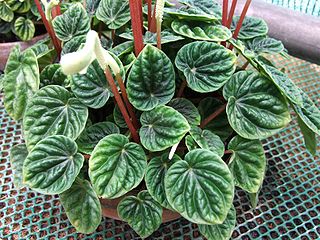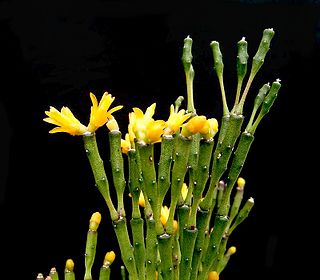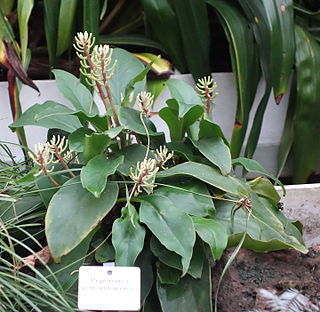
Peperomia is one of the two large genera of the family Piperaceae. It is estimated that there are at least over 1,000 species, occurring in all tropical and subtropical regions of the world. They are concentrated in South and Central America, but may also be found in southern North America, the Caribbean islands, Africa, Oceania, and southern and eastern parts of Asia. The exact number of species is difficult to determine, as some plants have been recorded several times with different names, and new species continue to be discovered. Peperomias have adapted to many different environments and their appearances vary greatly. Some are epiphytes or lithophytes, and many are xerophytes or possess underground tubers (geophytes). Most species are compact perennial shrubs or vines.

Veronica sect. Hebe is a group of plants within the genus Veronica, native to New Zealand, Rapa in French Polynesia, the Falkland Islands and South America. It was formerly treated as the separate genus Hebe. It includes about 90 species. Almost all species occur in New Zealand, apart from Veronica rapensis and Veronica salicifolia, found in South America. It is named after the Greek goddess of youth, Hebe. Informally, species in the section may be called shrubby veronicas or hebes.

Microcachrys tetragona, known as creeping pine or creeping strawberry pine, is a species of dioecious conifer belonging to the podocarp family (Podocarpaceae). It is the sole species of the genus Microcachrys. The plant is endemic to western Tasmania, where it is a low shrub growing to 1 m tall at high altitudes. Its leaves are scale-like, arranged in opposite decussate pairs, superficially resembling those of the unrelated Diselma archeri (Cupressaceae). It shares the common name Creeping pine with several other plants. Females produce tiny, red, edible berries in summer.

Millingtonia hortensis, the tree jasmine or Indian cork tree, is the sole species in the genus Millingtonia, a tree native to South Asia and South East Asia.

Peperomia graveolens, commonly known as Ruby Glow, is a species of plant in the genus Peperomia of the family Piperaceae. It is endemic to Ecuador.
Richard Pearce was a British plant collector, who introduced the tuberous begonia to England, which led to the development of the hybrid begonias grown today.

Sir Arthur William Hill was Director of the Royal Botanic Gardens, Kew, and a noted botanist and taxonomist.

Nymphaea leibergii, also known as the dwarf waterlily and Leiberg's waterlily, is a perennial emergent aquatic plant belonging to the genus Nymphaea. It can be found across northern North America in ponds and slow moving streams. Populations of this plant are infrequent throughout its range, and it is protected as a state threatened plant in Maine, Michigan, and Minnesota.

Peperomia caperata, the emerald ripple peperomia, is a species of flowering plant in the family Piperaceae, native to Brazil. It is a mound-forming evergreen perennial growing to 20 cm (8 in) tall and wide, with corrugated heart-shaped leaves, and narrow spikes of white flowers 5–8 cm (2–3 in) long, in summer.

Hatiora salicornioides, the bottle cactus, dancing-bones, drunkard's-dream, or spice cactus, is a species of flowering plant in the cactus family. A member of the tribe Rhipsalideae, it often grows as an epiphyte, natively in eastern Brazil and ornamentally elsewhere.

Peperomia obtusifolia, also known as the baby rubberplant, American rubber plant, or pepper face, is a species of flowering plant in the genus Peperomia under the family Piperaceae, native to Tropical America. The specific epithet obtusifolia means "blunt-leaved". The plant has gained the Royal Horticultural Society's Award of Garden Merit.

Peperomia pernambucensis is a species of plant in the genus Peperomia in the family Piperaceae. Its native range is in Central and South America from Nicaragua to Bolivia.

Nymphaea tetragona is an aquatic perennial, species of flowering plant commonly called pygmy waterlily and small white water lily, belonging to the family Nymphaeaceae.
Schinziella is a monotypic genus of flowering plants belonging to the family Gentianaceae. The only species is Schinziella tetragona.

Peperomia serpens, the vining peperomia, is a species of flowering plant in the genus Peperomia and family Piperaceae, native to the New World Tropics. The plant is perennial.

Peperomia nitida is a species of plant in the genus Peperomia. Its native range is in South America from Brazil to northern Argentina. It can be kept as a houseplant and is sometimes sold as cupid peperomia, or problematically as Peperomia scandens or Peperomia serpens.
Peperomia umbilicata is a species of flowering plant in the family Piperaceae. It is endemic to Peru. It is a geophytic plant, storing water and reserves in an underground tuber. During dry periods parts above ground, such as leaves, will wither away but the plant will survive due to the tuber. When more rain falls the plant regrows its stalks and leaves on the surface.

Peperomia magnoliifolia, commonly known as the spoonleaf peperomia, is a species of plant in the genus Peperomia. Its native range reaches from parts of southern Florida and Mexico to the Caribbean and northern South America including Uruguay.

Peperomia orba is a species of plant in the genus Peperomia of the family Piperaceae.

Peperomia eburnea is a species of plant in the genus Peperomia native to Colombia and Ecuador. It has a creeping or trailing growth habit, and grows in wet tropical biomes. Its foliage is green, and often has a single white stripe, along with red spotted backs of the leaves. Sodiro, who collected the type specimen for this species, described the red-mottled variant as maculata, but this variety is not scientifically accepted.

















